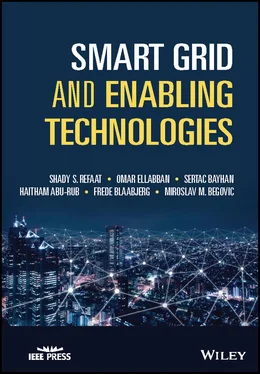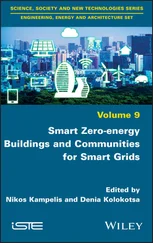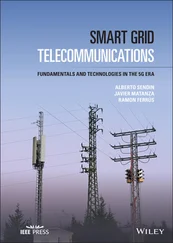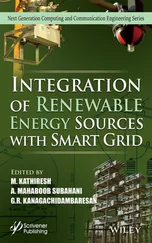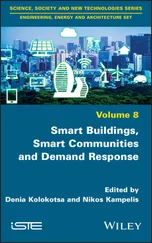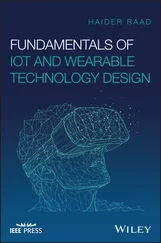Frede Blaabjerg - Smart Grid and Enabling Technologies
Здесь есть возможность читать онлайн «Frede Blaabjerg - Smart Grid and Enabling Technologies» — ознакомительный отрывок электронной книги совершенно бесплатно, а после прочтения отрывка купить полную версию. В некоторых случаях можно слушать аудио, скачать через торрент в формате fb2 и присутствует краткое содержание. Жанр: unrecognised, на английском языке. Описание произведения, (предисловие) а так же отзывы посетителей доступны на портале библиотеки ЛибКат.
- Название:Smart Grid and Enabling Technologies
- Автор:
- Жанр:
- Год:неизвестен
- ISBN:нет данных
- Рейтинг книги:3 / 5. Голосов: 1
-
Избранное:Добавить в избранное
- Отзывы:
-
Ваша оценка:
- 60
- 1
- 2
- 3
- 4
- 5
Smart Grid and Enabling Technologies: краткое содержание, описание и аннотация
Предлагаем к чтению аннотацию, описание, краткое содержание или предисловие (зависит от того, что написал сам автор книги «Smart Grid and Enabling Technologies»). Если вы не нашли необходимую информацию о книге — напишите в комментариях, мы постараемся отыскать её.
Smart Grid and Enabling Technologies
Smart Grid and Enabling Technologies
Smart Grid and Enabling Technologies — читать онлайн ознакомительный отрывок
Ниже представлен текст книги, разбитый по страницам. Система сохранения места последней прочитанной страницы, позволяет с удобством читать онлайн бесплатно книгу «Smart Grid and Enabling Technologies», без необходимости каждый раз заново искать на чём Вы остановились. Поставьте закладку, и сможете в любой момент перейти на страницу, на которой закончили чтение.
Интервал:
Закладка:

Figure 1.17 The difference between the conventional power grid and smart grid structure.
Table 1.1 A detailed comparison between conventional power grids and smart grids.
| Characteristics | Traditional grid | Smart Grid |
|---|---|---|
| Technology | ElectromechanicalMechanical devices electricity operatedNo communication between devicesLittle internal regulation | DigitalDigital devicesIncreased communication between devicesRemote control and self‐regulation |
| Flow of power and communication | One wayPower flow starts from the main plant using traditional energy structure to the customer | Two wayPower flow goes to and from various grid users |
| Generation | Centralized | Distributed |
| Fault location | Difficult to determine | Can be determined remotely as well as predicted |
| Monitoring | Manual | Self‐ monitoring |
| Equipment failure | System responds to deal with post failure and blackout incidents | Adaptive and can be isolated and automatically reconnected. |
| Control | Limited control system | Pervasive control system |
| Operation and maintenance | Manually equipment checks | Remotely monitor equipment |
In summary, transforming to SG paradigm will help in the wide‐scale integration of energy sources, enhancing network reliability, and improving power quality and load profile.
1.8.2 Basic Stages of the Transformation to SG
Successful transformation to SG requires a real, national level roadmap. Many countries have already established their SG roadmaps [55–60]. Each country has its own unique definition of a SG based on their own policies, goals, and objectives. The transformation roadmap should be developed based on different technical and economic realities and challenges facing each country. To develop a complete SG Roadmap that responds to the nation's electric power sector goals, some basic stages should be involved to define the priorities of their energy sectors. Also, there is a need for specific objectives, actions, and tools to fully achieve the roadmap set goals. Examples of steps and targets that countries put to transform traditional grid into SG are:
1 Install smart meters and AMI around the entire country by a specific time.
2 Significant percentage of cars to become electric within a specific time.
3 Specific reduction of country's emissions by a specific year.
4 Significant level of renewable generation by a specific time.
5 New tariff system.
6 Activating a DSM and customers activated role before a specific year.
7 Establish effective information and big data centers with a clear strategy for secure data storing and utilization. Timely publish current and historical data that is not confidential nor sensitive.
8 Building human capacity by adopting specific training programs on SG areas.
1.9 Smart Grid Enabling Technologies
The current technology revolution is leading to unwitnessed shifts in the economy, society, business, and individuals. A great effort is being made worldwide toward clean energy in order to protect the environment and improve operational efficiencies and customer services for better grid availability and reliability. The transfer of the traditional grid to a SG requires modifications and upgrades at various levels of the electric grid [61]. Nowadays, information and communication technologies are being developed very quickly and can significantly support the SG vision. This transformation is pushed by several factors, which include electrification, decentralization, and digitalization as shown in Figure 1.18. Those drivers work in harmony to assist in enabling, scaling up, and reinforcing advancements in SGs. Decentralization enables active elements of the system but requires a high level of coordination. Digitalization supports electrification and decentralization by having better management, which includes automatic control, consumption real‐time optimization, and interaction with customers.
1.9.1 Electrification
Electrification is the process of powering by electricity and, within the context of the SG principle [62]. As the electricity generation in the SG moves toward more renewable sources, this trend enables more environmental gains and adding to it more end sectors such as heating, transportation, away from fossil fuel resources. This trend also increases the efficiency of energy utilization. An example of electrification is using EVs in transportation. This technology has been evolving rapidly over the past five years. The EV range was improved to exceed 480 km for particular models. Batteries' costs which were above $1100 per kilowatt‐hour in 2010, have fallen 87% in real terms to $156/kWh in 2019 [63]. These reductions have reduced the cost gap with traditional internal‐combustion engine vehicles. It's expected to have economically competitive EVs, although multiple electrification challenges within the infrastructure can limit the successful adaptation rate of EVs. The deployment of EVs boosts electricity consumption and offers a huge opportunity to maximize the utilization of the grid. This can be achieved if the charging/recharging technology is combined with suitable pricing and flexible usage. Electrification and economic growth are highly correlated [64].
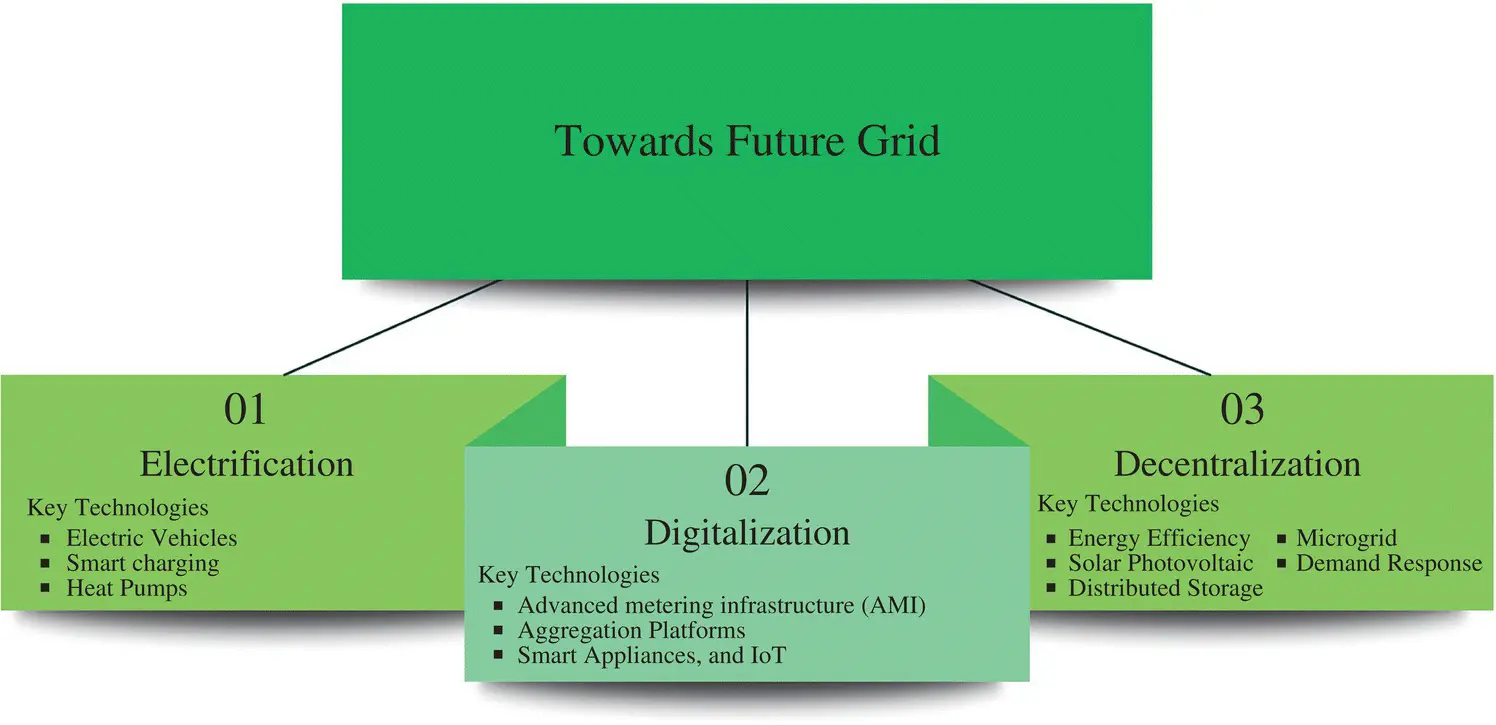
Figure 1.18 Three trends of the grid edge transformation.
1.9.2 Decentralization
Decentralization is the transformation of the bulk, “one‐way direction” of energy into a distributed, multi‐directional flows, known as multi‐lane highways [65]. A decentralized electrical grid has several environmental and security benefits. Microgrids coordinated with distributed energy generation give systems significantly enhanced reliability and grid efficiency. Distributed power generation and microgrids are independent of the grid which means this power is provided to the local loads even when the main grid is not available. Decentralized generation allows the reduction of power outages for critical facilities, for instance, hospitals or police stations or any facility that may need continuous power. Hence, decentralized grids are more energy‐efficient than centralized electricity grids [47]. Consequently, implementing renewable energy sources in the current power grid does not automatically imply that the current power grid is decentralized. The transformation from a centralized to a decentralized electricity grid requires a number of technologies with various implications that need to be considered to become a reality such as [66]:
1 Distributed generation (from renewable energy resources).
2 Distributed storage.
3 DR.
1.9.3 Digitalization and Technologies
Advancements in digitalization enhance the grid's utilization and management. Technologies that are digitalized have been increasingly used to allow devices across the grid to exchange beneficial data for the customers and grid operators. There is a huge interest in utilizing innovative Internet of Things (IoT) sensors, smart meters, network remote automation, distributed and centralized control systems, digital platforms, to spot the light on the grid's proper optimization and aggregation, enable real‐time operation of the network, and enhance grid's situational awareness and utility services [67]. The rise in the deployment of AMI shows clear opportunities for enhancing the quality of service, the observability of the network, and data gathering for short‐ and long‐term utilization. The grid's various digital data provides opportunities for fault detection, energy consumption and generation, as well as prediction of faults and outages. Digitalization of the network is an obvious opportunity for cost‐effective development and management of the electricity system with high returns in cost and quality to serve. On the consumer side, chances for the use of smarter customer technologies are being increased. The installation of digital technologies in the network should not be slowed down by outdated regulations. As more digital devices are deployed, the communication between these devices will be increased. Broadband communication infrastructure will support a wide range of services (both network and consumer services). Not having updated policies and standards can slow down the development of this infrastructure and hinder innovation in this space. There are more challenges for digitalization including available infrastructure and replacement cycles [68]. Technologies related to the SG have evolved from previous attempts at utilizing electronic control, metering, and monitoring. Back in the 1980s, automatic meter reading was implemented to keep track of loads from heavy consumers and emerged into the AMI of the 1990s [69]. These meters can record and store how electricity is utilized at various times of the day. Smart meters give continuous information so that monitoring can be achieved in real‐time and could be utilized as a gateway for “smart sockets” in the premises and for DR‐aware equipment [70]. The main technologies in the SG consist of three main parts: electric energy technologies, operation technologies, and information and communication technologies as described in Figure 1.19. Energy technologies include renewables energy, distribution generation, DR, EVs, ES, integrated gasification combined cycle, etc. The operation technologies refer to a variety of hardware and software that detect or cause a change through direct monitoring and/or control of physical devices, processes, and events in the SG [71]. It includes the EMS, distribution management system (DMS), DSM, SCADA, outage management system (OMS), asset management system (AMS), flexible alternating current transmission system (FACTS), wide area monitoring systems (WAMS), process control application (PCA), etc. The information technologies include enterprise resource planning, portals/gateways, information management, sensing and measurements, asset management, data collection, storing, mining, and analytics. Communication technologies, which include Wireline and Wireless technologies. The Wireline technologies include PLC, fiber‐optic, Digital subscriber line (DSL). Wireless technologies include Wi‐Fi, Worldwide interoperability for microwave access (WiMAX), Global System for Mobile Communications (GSM), and Satellite. The technology in SGs can be divided into different areas, each consisting of sets of assets, starting from generation through transmission, distribution, and different consumers [72, 73].
Читать дальшеИнтервал:
Закладка:
Похожие книги на «Smart Grid and Enabling Technologies»
Представляем Вашему вниманию похожие книги на «Smart Grid and Enabling Technologies» списком для выбора. Мы отобрали схожую по названию и смыслу литературу в надежде предоставить читателям больше вариантов отыскать новые, интересные, ещё непрочитанные произведения.
Обсуждение, отзывы о книге «Smart Grid and Enabling Technologies» и просто собственные мнения читателей. Оставьте ваши комментарии, напишите, что Вы думаете о произведении, его смысле или главных героях. Укажите что конкретно понравилось, а что нет, и почему Вы так считаете.
